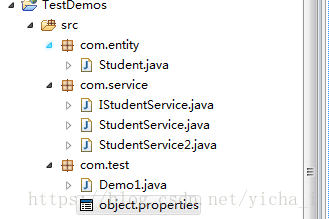- java中产生对象的两种方式:new与反射
- java中配置文件形式:properites与xml
- 面向接口的好处:不满意原来的实现方式时,可以写一个新的实现类,只改动配置文件,无需改动源码

package com.service;
import com.entity.Student;
public interface IStudentService {
public void addStudent(Student s);
}
package com.service;
import com.entity.Student;
public class StudentService implements IStudentService {
@Override
public void addStudent(Student s) {
System.out.println("IStudentService接口实现类1"+":用时10秒");
}
}
package com.service;
import com.entity.Student;
public class StudentService2 implements IStudentService {
@Override
public void addStudent(Student s) {
System.out.println("IStudentService接口实现类2"+":用时1秒");
}
}
package com.test;
import java.util.Properties;
import com.entity.Student;
import com.service.IStudentService;
public class Demo1 {
/**
* @param args
* @throws ClassNotFoundException
* @throws IllegalAccessException
* @throws InstantiationException
*/
public static void main(String[] args) throws Exception {
Student s1 = new Student();
s1.setName("张三");
System.out.println(s1.getName());
Student s2 = (Student) Class.forName("com.entity.Student").newInstance();
s2.setName("李四");
System.out.println(s2.getName());
Properties pro = new Properties();
pro.load(Demo1.class.getResourceAsStream("object.properties"));
IStudentService service = (IStudentService) Class.forName(pro.getProperty("name")).newInstance();
service.addStudent(null);
}






 本文探讨了Java中面向接口编程的优势,展示了如何通过修改配置文件来切换不同的实现类,而不需改动源码。同时,介绍了Java中对象生成的两种方式:new与反射,并比较了properties与xml作为配置文件的形式。
本文探讨了Java中面向接口编程的优势,展示了如何通过修改配置文件来切换不同的实现类,而不需改动源码。同时,介绍了Java中对象生成的两种方式:new与反射,并比较了properties与xml作为配置文件的形式。

















 被折叠的 条评论
为什么被折叠?
被折叠的 条评论
为什么被折叠?








